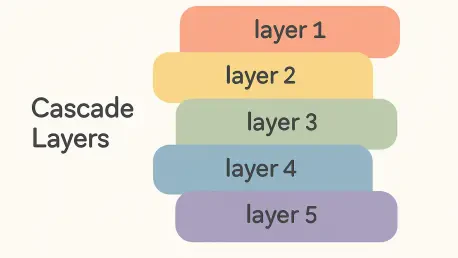Diving into the evolving world of CSS, we’re thrilled to sit down with Vijay Raina, a renowned expert in enterprise SaaS technology and software design. With a deep background in software architecture, Vijay has a unique perspective on modern web development challenges, particularly when it comes to integrating cutting-edge CSS techniques like Cascade Layers into existing projects. Today, we’ll explore his insights on refactoring legacy code, managing specificity, and creating maintainable stylesheets that stand the test of time. From the motivations behind adopting new CSS features to the gritty details of overcoming codebase chaos, this conversation promises to unpack the real-world intricacies of modern styling practices.
How did you first come across CSS Cascade Layers, and what sparked your interest in applying them to existing projects?
I stumbled upon CSS Cascade Layers while researching ways to tame the chaos of specificity in large CSS codebases. They immediately caught my attention because they offer a structured way to manage styles by defining priority explicitly, rather than relying on the usual selector weight battles. What got me really excited was the potential to apply them to existing projects—those messy, inherited codebases that many developers dread. I saw it as a chance to bring order to chaos without starting from scratch, which is often not an option in real-world scenarios. It’s about making the old play nicely with the new, and that challenge hooked me right away.
What do you see as the biggest advantage of using Cascade Layers when dealing with a legacy CSS codebase?
The biggest advantage, hands down, is how they simplify specificity management. In a legacy codebase, you’re often wrestling with a tangle of styles where ID selectors, !important declarations, and overly specific rules create a nightmare to maintain. Cascade Layers let you define an explicit order of precedence, so you can group styles by purpose—like resets, base styles, or components—and know exactly which rules will win out. This makes the code more predictable and easier to debug or extend. Plus, it’s a huge win for maintainability since you can find and update styles without second-guessing their impact across the project.
Can you share how you approach the initial overwhelm of diving into a messy or unfamiliar CSS codebase for refactoring?
It’s definitely daunting at first. My strategy is to start by stepping back and analyzing the big picture. I skim through the CSS to spot red flags—things like heavy use of !important, ID selectors, or massive code repetition. Then, I map out a rough plan by defining what layers I’ll need based on the project’s structure, like separating resets from layouts or components. This gives me a framework to lean on. I also focus on small, incremental changes rather than trying to fix everything at once. For instance, I might tackle one section, test it, and ensure nothing breaks before moving on. It’s about building confidence in the code as I go, turning chaos into clarity one step at a time.
What motivated you to integrate Cascade Layers into an existing project rather than building a demo from the ground up?
Building a demo is great for learning, but it’s too clean, too controlled. Real-world projects are messy—they come with technical debt, quirky decisions, and styles that somehow work despite themselves. I wanted to tackle an existing project to show how Cascade Layers can be applied in situations where most developers actually encounter them: inheriting a codebase you didn’t write. It’s a more authentic challenge. Refactoring something real, like a landing page with navigation and hero sections, lets me address genuine pain points—specificity conflicts, unclear organization—and demonstrate practical solutions that others can adapt to their own messy projects.
How do you decide on the structure and priority of layers when refactoring a project’s CSS?
Deciding on layer structure starts with understanding the project’s needs and breaking styles into logical buckets based on their role. I typically go with layers like reset for browser defaults, base for core HTML styles, layout for structural positioning, components for reusable UI pieces, and utilities for single-purpose helpers. The priority order follows a natural progression—reset comes first as the foundation, then base, and so on, with utilities or animations often last since they’re usually overrides or specific enhancements. This order ensures later layers can build on or override earlier ones predictably. I define this structure upfront in the stylesheet so it’s clear from the get-go how styles cascade, avoiding guesswork as I refactor.
What’s one particularly tough moment you’ve faced during a CSS refactoring process, and how did you push through it?
One tough moment was early in a project when I realized the codebase was littered with !important declarations that completely flipped the layer priority system. It was frustrating because I had defined my layers, started moving styles, and suddenly nothing behaved as expected. I had to pause and rethink my approach. I decided to tackle it by first auditing and removing as many !important tags as possible, replacing them with better specificity or layer adjustments. It was tedious, but I took it section by section, testing each change to ensure the design didn’t break. That slow, methodical grind—coupled with a lot of coffee—got me through. It taught me to anticipate those curveballs and address them systematically.
How do you handle decisions around media queries when integrating Cascade Layers, and what influenced your approach?
Media queries were a real puzzle for me. I debated whether to isolate them in a dedicated responsive layer or keep them with their related elements. After some testing and research, I settled on nesting them within the same layer as the elements they affect—like keeping a button’s responsive styles in the components layer with its base styles. This approach keeps related code together, making it easier to maintain and predict overrides. It aligns with component-based thinking, which is huge in modern development. The downside is that responsive logic gets scattered across layers, but I find that less problematic than separating base and responsive styles, which can lead to forgotten updates and inconsistencies.
Why do you advocate for replacing ID selectors with class selectors during refactoring, and what impact does this have?
I’m a big believer in using class selectors over IDs because IDs carry way too much specificity weight, often leading to conflicts and hard-to-override styles in a codebase. When you’re refactoring, swapping IDs for classes lowers the specificity by default, making the CSS more flexible and easier to manage. It prevents those specificity wars where you end up piling on more selectors or resorting to !important just to override something. The impact is huge—it flattens the playing field, so styles in your Cascade Layers behave as intended based on layer priority, not some rogue ID selector. Plus, classes are inherently more reusable, which aligns with a modular, maintainable approach.
Can you walk us through how Cascade Layers have improved maintainability in a project you’ve worked on?
Absolutely. In one project, a typical landing page with a nav bar and hero section, the original CSS was a sprawling mess—over 400 lines with no clear organization. After refactoring with Cascade Layers, I grouped styles into distinct roles: resets, base styles, layouts, components, and utilities. Suddenly, finding a specific style—like a button component—was straightforward because it lived in the components layer. Adding new features became easier too; I knew exactly where to slot in a new utility or component without worrying about unintended overrides. Layers made the stylesheet a map instead of a maze. While it didn’t magically fix everything—like underlying HTML issues—it gave the team a clearer path to maintain and scale the styles over time.
What’s your forecast for the future of CSS Cascade Layers in web development?
I think CSS Cascade Layers are poised to become a cornerstone of modern web development, especially as projects grow in complexity and teams need better ways to collaborate on styles. With browser support already pretty strong—over 90% as of now—I expect adoption to keep climbing as more developers see the benefits of structured specificity management. They’re likely to integrate even deeper with design systems, where modularity and predictability are key. We might also see tooling evolve to support layers more explicitly, like linters or editors highlighting layer priorities. My forecast is that in a few years, working without layers in medium-to-large projects will feel as outdated as writing CSS without a preprocessor did a decade ago. They’re a game-changer for maintainability, and I’m excited to see how the community builds on them.









